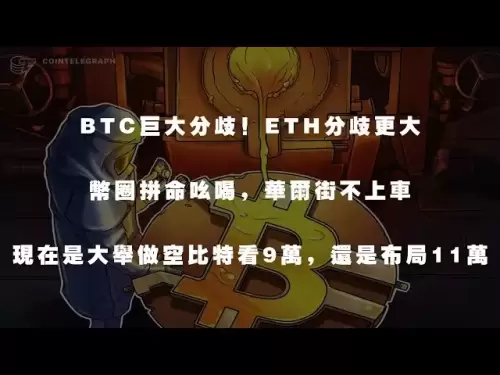 |
|
 |
|
 |
|
 |
|
 |
|
 |
|
 |
|
 |
|
 |
|
 |
|
 |
|
 |
|
 |
|
 |
|
 |
|
Cryptocurrency News Articles
Not all good news is a buy signal. Sometimes, the most positive headlines mark a turning point
May 15, 2025 at 09:51 am
The first week of May 2025 saw a flood of positive headlines pour into the crypto market. Bitcoin surged past $103,000 for the first time since January.

The first week of May saw a swift market correction after a wave of good news pushed Bitcoin past $103,000 and the Fear & Greed Index soared to 70. At the same time, U.S. jobless claims dropped to 228,000, fueling investor optimism that the Fed might hold interest rates steady or even begin a rate-cutting cycle in Q3. The bullish sentiment sent altcoins like SOL, AVAX, TON, and INJ up by more than 15% over just four trading sessions.
However, within less than 48 hours, the market reversed sharply, with Bitcoin slipping below $101,800 and Ethereum falling back to around $2,100. Many altcoins also shed between 5% and 10% of their value as investor sentiment turned cautious and capital began rotating out of the week’s top gainers. Once again, the crypto community began discussing a familiar phrase: “Sell the News.”
Good news doesn’t always mean price gains, especially in crypto, where reactions are faster and greed often outweighs fundamentals.
One of the most classic examples was the launch of the ProShares Bitcoin Futures ETF (BITO) in October 2021. In the lead-up to approval, BTC rallied nearly 40%, from $43,000 to an all-time high of $67,000. However, just three days after the ETF began trading on the NYSE, Bitcoin reversed sharply and entered a months-long correction, ending the year at $47,000. Investors had expected good news to drive fresh inflows, but instead, it marked a sentiment top.
A similar pattern emerged in January 2024, when the SEC rejected multiple Spot Ethereum ETFs and markets dipped only modestly. Then, as rumors of approval resurfaced in late February, ETH surged from $1,650 to $2,300 in just 10 days. But after the SEC officially greenlit four Spot ETH ETFs in March, ETH unexpectedly dropped 12% during the first week following the announcement.
More recently, in April 2025, Pudgy Penguins’ $PENGU token soared to $0.48 after a Walmart partnership announcement and a spike in Google Trends interest. Just one day later, the token crashed over 60% as the team unlocked a large tranche of tokens for the community.
The meme coin market has also repeatedly echoed this pattern. In December 2023, BONK on Solana jumped over 300% in six days as rumors spread of a major centralized exchange partnership. Yet just two days after the news was confirmed, BONK lost nearly half its value within 48 hours.
The “Sell the News” phenomenon usually isn’t because the news itself is bad, but rather, the market has already “priced in” the good news, with expectations running ahead of reality. According to CryptoQuant, between April 28 and May 10, stablecoin inflows to exchanges rose by 27%, indicating that investors were proactively preparing liquidity to “ride the news.”
However, during the same period, the number of whale wallets (holding between 1,000 and 10,000 BTC) remained largely flat, suggesting that the new inflows came primarily from short-term speculators. This aligns with a common pattern in crypto, where price rallies are often driven more by FOMO than long-term accumulation.
Technical indicators also flashed warnings. On May 9, the daily RSI for both Bitcoin and ETH surpassed 70, signaling overbought conditions. Meanwhile, trading volume began to decline even as prices kept rising – a classic setup for a potential reversal. Data from Glassnode further showed a modest uptick in BTC deposits to exchanges on May 10, which coincided with the market’s short-term top.
There’s no one-size-fits-all answer to whether you should hold or sell when good news breaks. But three fundamental principles can help guide decision-making:
First, assess the underlying value of the information. A technical upgrade (like Ethereum’s Pectra) may offer long-term benefits, while token listing announcements or airdrops often provide only short-term upside.
Second, monitor capital flows. If TVL, active users, and on-chain metrics remain largely unchanged after a major announcement, there’s a high probability that the rally is sentiment-driven and unlikely to last.
Lastly, establish your exit strategy in advance – including clear profit-taking levels or leverage reductions. Making decisions amid volatile market moves often leads to emotional reactions and unexpected losses.
Disclaimer:info@kdj.com
The information provided is not trading advice. kdj.com does not assume any responsibility for any investments made based on the information provided in this article. Cryptocurrencies are highly volatile and it is highly recommended that you invest with caution after thorough research!
If you believe that the content used on this website infringes your copyright, please contact us immediately (info@kdj.com) and we will delete it promptly.
-

-

-

-

-

- What if a single coin could simplify digital finance and make real-world assets tradable on-chain, seamlessly?
- May 15, 2025 at 01:50 pm
- That’s what Qubetics ($TICS) brings to the table. While many previous tokens overpromised and underdelivered, $TICS is set to break barriers by directly tackling inefficiencies
-

-

-

-

- Staring a New Bull Market Rampage, Crypto Strategist Predicts SUI (Sui) Will Follow in the Footsteps of Solana's (SOL) 2020-2021 Price Action
- May 15, 2025 at 01:40 pm
- A widely followed crypto strategist thinks that one layer-1 platform is closely following in the footsteps of Solana's (SOL) 2021 bull market rampage.























![[Ronnie Trading Guide]-2025.5.15-Bitcoin continues to consolidate at a high level, and only patient investors will get a return on time~ [Ronnie Trading Guide]-2025.5.15-Bitcoin continues to consolidate at a high level, and only patient investors will get a return on time~](/uploads/2025/05/15/cryptocurrencies-news/videos/ronnie-trading-guidebitcoin-continues-consolidate-level-patient-investors-return-time/682574fd46a42_image_500_375.webp)



































